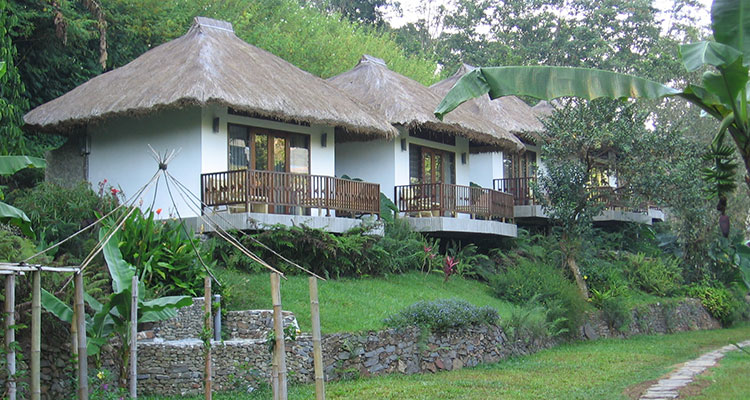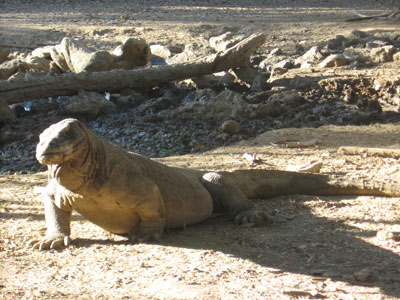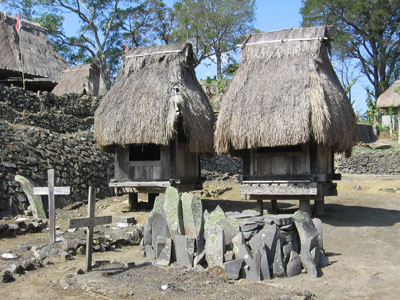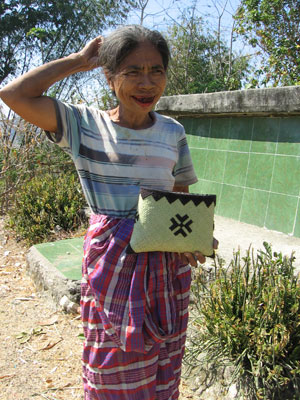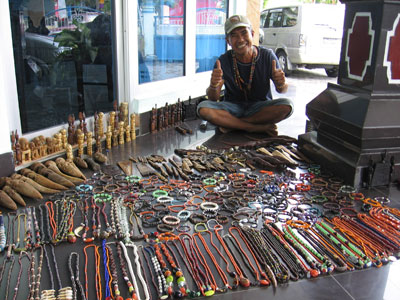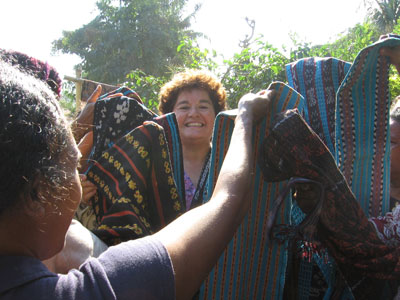From Lombok to Sumba – exploring the islands east of Bali
This article appears on page 18 of the December 2012 issue.
Esther Perica with Joan Cockell; Arlington Heights, IL
I never thought I’d get to Indonesia’s Lesser Sunda Islands, a group of islands located east of Bali, but two longtime friends and ITN readers, Joan Cockell and Stan Bach, expressed a common interest in this destination, so I signed on to join them on an August 2011 adventure.
Making plans
As Joan, Stan and I researched our trip, we learned good things about Floressa Bali Tours (Denpasar, Bali; phone 011 62 361 467625), a company that had favorable reviews in ITN.
The itinerary that captured our interest was Floressa’s 16-day “Lesser Sunda Islands,” with visits to Lombok, Sumbawa, Komodo, Flores, West Timor and Sumba.
We had the pleasure of dealing with Paul Edmundus, Managing Director, who was easy to work with, answered our e-mails within 24 hours, was clear, concise and explicit in all correspondence and was responsive to our needs while we were traveling.
We paid $2,835 per person, each with single occupancy of a double room, plus $360 for internal air (four flights). This cost included our accommodations; an air-conditioned car with driver; an English-speaking guide; all meals during the 16 days except for two dinners in Lombok; transfers for all internal flights; entrance fees; donations in each village we visited, and a 2-day sailing trip to Komodo Island on a private boat. Camera fees on Komodo Island and a hike at Kelimutu Volcano were extra and were paid locally.
When Mr. Edmundus converted the tour price from Indonesian rupiah (IDR) to US dollars so we could pay by credit card, he gave us a very generous exchange rate. This is a top-notch, professional operation!
Lombok and Sumbawa
Bali was a good beginning and ending point for this trip and a great place to spend a few extra days, but the tour officially began with our arrival at Mataram Airport in Lombok and ended on day 16 upon our arrival at Bali’s Denpasar International Airport. We had Floressa Bali Tours arrange additional pre- and post-tour hotel and touring services for us.
We had two types of vehicles on this trip. Each was rugged enough to be able to swerve over potholes, go over high ridges and deal with road construction and rockfalls.
In Lombok and Flores we had a Toyota Innova that, when packed with luggage, three travelers, a guide and driver, was a bit tight. This model would be better suited for two travelers. We much preferred the Isuzu Panther that we used later in Timor and Sumba, which was larger and more comfortable for our group of three.
We enjoyed traveling overland rather than flying from place to place, as it gave us a feeling for the size of the country.
We started our tour with a 2-night stay at the Sheraton Senggigi Beach Resort in Lombok, a 4-star property. It was gentle touring there, with visits to a Sasak community, a pottery cooperative and some craft markets. We spent the next day on Gili Air, a small jewel of an island off the coast of northwestern Lombok, which gave us an opportunity to snorkel, enjoy the beach and have a terrific fish lunch.
Then we took a ferry trip to Sumbawa Island, reputed to have some nice beaches with surfing in the south plus mines, salt farms, fishing and lots of agriculture, but we found it less interesting and less scenic than the other islands we visited. According to the Lonely Planet guidebook, it’s the “domain of surfers, miners and mullahs.”
Both Lombok and Sumbawa islands are predominantly Muslim, and people become more conservative the farther east you travel.
Komodo
After an overnight in Bima, Sumbawa, we drove to the port of Sape, where we boarded our wooden boat Komodo Shalom 02 for an overnight trip to Komodo Island, home of the largest monitor lizards in the world. We had the entire boat (which sleeps 12) to ourselves along with a crew of six and our own guide, Arnoldus.
While sailing, we spent most of our time on deck spotting flying fish, looking for swimming turtles and dolphins and enjoying the cool breezes and spectacular scenery as we cruised among small, uninhabited islands. We slept in one large cabin with six sets of bunk beds, allowing each of us the exclusive use of four beds. One bathroom with a rudimentary shower was reserved for the three of us, while the guide and crew used the other.
Meals were served on deck, and we were treated to a full array of seafood, fish, pastas, vegetables and snacks. Mineral water was also provided.
Komodo National Park, consisting of Komodo Island and 28 smaller islands, is a UNESCO World Heritage Site. Komodo Island is made up of savanna-covered jagged hills fringed with mangroves. It has a small fishing community of about 1,500 people and a good-size population of around 1,300 Komodo dragons. Remember where it was written on antique maps, “Beyond this point there be dragons”? This is the place they were talking about.
On our first afternoon, we used a rowboat to get from our boat to the Komodo Island pier to meet our ranger, who was armed with a Y-shaped stick in case he needed to repel a dragon. Then we took a 2½-mile walk to search for those dragons.
These huge lizards can grow up to nine feet in length and weigh 300 pounds. They have long, forked, yellow tongues, sharp teeth and razor-like claws. If they don’t kill you right away, the bacteria in their saliva will poison you and you’ll die a slow, horrible death.
Not far into our walk, we encountered a ranger coming the other way who told us a dragon on our trail had just killed a wild pig. When we arrived, it was trying to drag its prey into the bushes to eat it.
We took some great pictures of this before being interrupted by the arrival of a Dutch group. In their excitement, they went in too close and the dragon, thinking they were going to steal its pig, threatened to charge them. We observed the stampede from a safe distance.
The next morning we returned to the island for an additional hike and found our friend the dragon basking in the sun, drool dripping from its mouth and its distended belly hanging heavy on the ground. Later on the walk, our ranger, with the unlikely name Tarzan, showed us flying lizards, numerous tropical birds, a megapode nest, deer, monkeys, medicinal plants and the former feeding station. (They stopped feeding goats to the dragons in 1994.)
On Komodo it’s mandatory to be escorted to the toilets, as there is a group of lazy dragons that hang out near the rangers’ camp kitchen hoping to be fed. These toilets were worth the trouble, though, as they were much nicer than most of the public toilets on our tour.
We sailed to the other side of the island to Pink Beach for snorkeling, which, both Joan and I agreed, was some of the best we’d ever done. We had visibility of at least 50 feet.
We were guarded on the beach by our own guide and several rangers just in case one of the island’s predators decided to go swimming. We never called for Tarzan’s help.
Flores
Our next five days were spent on Flores Island. We all loved this stunningly beautiful, lush, mountainous island with many volcanoes.
Our first night was spent in Ruteng at the Susteran S. Maria Berdukacita Hotel (and nunnery), run by the Sisters of the Sorrowed Mother Mary. The rooms were small but antiseptically clean and tidy. We were even invited to join the good sisters at Mass at 6 a.m.
We continued to the village of Bajawa to visit members of the Ngadha tribe, who maintain their animist beliefs. The umbrella-shaped structures at the center of each village represent “male” spirits, and the small, thatched-roof huts sitting opposite represent the “female.” The number of these ngadhu and bhaga in a village correlates to how many clans live there.
There is heavy betel-nut chewing by the tribe members, and most people we met had swollen red gums and very few teeth.
En route to Kelimutu Volcano we visited the village of Boawae, where the men had just completed their annual traditional deer hunt followed by feasting and celebrating. Stan was allowed to join the men, but Joan and I had to walk around their area to reach the women, who were busy cooking up a big pot of pork and veggies, the deer already having been consumed.
In Moni we stayed at one of the best hotels of the trip, Kelimutu Crater Lakes Eco Lodge. Each of us had a lovely villa with a balcony facing Kelimutu Volcano. My room was large and well appointed, with excellent lighting and open-roofed (but very private) bathroom facilities. The walls were embellished with the unique blue stones found only on Flores’ Nanga Panda beach. The made-to-order breakfast was good, too!
Flores is well known for its textile art, especially that from the town of Sikka. As soon as we were spotted, women would come out of their houses with armfuls of magnificent weavings to sell. Larger weavings ran IDR250,000 to IDR400,000 ($26-$42) and smaller pieces IDR50,000 to IDR150,000 ($5-$16).
There were about 25 women all hoping to sell their goods, so they were a bit aggressive. We again experienced this “enthusiasm” in Pau (near Rende) in Sumba.
Timor
Next we flew to West Timor. We spent just two nights in Kupang, the capital, and drove three hours each way to the town of Soe to see their beehive houses.
We all liked the way the guides handled village visits on the islands. First we’d stop at the headman’s house and the guide would exchange a few pleasantries (and sometimes cigarettes) with him, signing the guest book and giving a donation. Then the guide would take us around, pointing out areas of interest. This was followed by free time to explore and take photographs.
More often than not, as soon as the local women saw us, they assembled a little market of weavings, carvings, basketry and handmade kitchenware and knives. We’d usually do just one round of bargaining (just to be polite), then we’d buy.
Though we were on Timor only one full day to visit Soe, we didn’t feel deprived.
Sumba
Next it was on to Sumba, an island with unique tribal societies as well as the shopping highlight of the trip: Sumbanese-style ikat weavings, carvings and tribal artifacts. A special note on ikat — this method of weaving uses threads that are tie-dyed before being woven, resulting in a very intricate pattern. Ikat designs from the various islands are distinctive, and the origin of each can be easily identified.
Though people throughout Indonesia weave ikat, the eastern Sumbanese ikat is much more intricate. It can take from a few months to years to finish a piece, depending on the motif, the number of dyes used and the final size.
The weavers pride themselves on using natural dyes, and each piece is filled with ethnographic symbolism.
It is not inexpensive. The pieces we saw in Sumba were a major step up in quality and price from what we had seen on other islands. Quoted prices there were IDR1,500,000 to IDR4,000,000 ($156-$416). Merchants who deal in high-quality goods generally accept US dollars as well as euros.
Sumba was the most undeveloped island we visited. Upon our arrival, our guide, Daniel Landiamara, issued each of us a packet of wet wipes, a roll of toilet paper and a bottle of cold water. All of it came in very handy!
Though there is a strong Christian influence on the island, most villagers maintain a belief in their animist religion, and rural life revolves around ancestor worship, or Marapu. Death dominates life there, and the Sumbanese are especially known for their burial rituals and the unique tombstones located at the center of each village. This is the way they keep the spirits of their loved ones included in their daily lives.
Looking a bit like an Irish dolmen, each tomb consists of four to six stone pillars, often highly decorated, supporting a large, flat, horizontal capstone. Underneath, there is a chamber for the remains of the deceased and his family.
There are a few rajas (kings) left on Sumba, and we visited with a royal family in the small village of Rende. Regrettably, slaves are still a part of their culture — something we had great difficulty coming to terms with.
As we explored the area, we found the people of Rende very gentle and kind.
We ended our tour in Waikabubak at the Monalisa Cottages, located at the edge of town. It was adequate but basic — no hot water and sometimes no running water. The bathroom had a tank with water to use to flush the toilet and take a “splash bath.” Hot water in a bucket was provided upon request for delivery in the evening or the morning.
However, the staff was exceptionally friendly, especially Adri, an energetic 18-year-old who spoke a little English and seemed to be “in charge” of us. Each afternoon, the hotel provided a nice snack and tea or coffee when we returned from our touring.
If a traveler would like a bit more luxury in amenities (including hot water!) and would like to be closer to a beach, the French-owned Sumba Nautil Resort (phone +62 813 39 55 8652, www.sumbanautilresort.com) might be a better choice. It is a newer, more modern property and, of course, more expensive, at around $50 (room) to $100 (cottage) per night. We visited this impressive property when our guide stopped to return a previous guest’s room key. It was a bit of a letdown to return to our humble, basic lodgings.
When we returned to Bali at the end of our tour, the Floressa Bali Tours staff treated us to lunch and gave us gifts. It was a nice surprise. More importantly, it gave us a chance to meet and personally thank the staff members who had made our Lesser Sunda Islands program such a success.
A few travel tips
In dealing with money on the islands, be prepared to carry around a lot of paper. The exchange rate hovered around IDR8,500 to $1. For the meager sum of approximately $125, I could be a millionaire! (The rate at the time of publication was IDR9,620 per $1.)
US currency should be clean, with no writing or tears. Locals like the latest circulation date possible, and 100-dollar bills get the best exchange rate.
You’ll need to obtain small bills, as 5,000-, 10,000- and 20,000-rupiah notes are the most useful in the more remote areas, since people often will not have change. Don’t worry if you end up with a heap of low-denomination bills at the end of your trip. They’re handy for paying the international departure fee of IDR150,000 ($16) before your flight home. I paid the entire amount with a pack of 5,000-rupiah notes!
It is easier and quicker to use money changers in Bali and Lombok, but we found better rates using ATMs in Sumbawa, Flores and Sumba. ATMs are generally found in the larger towns, and there is a sign at each indicating if it dispenses 50,000- or 100,000-rupiah notes. Instructions were always available in English.
At the time of my visit, the limit was IDR1,200,000 for each transaction, with a daily limit of IDR5,000,000. If needed, you can do multiple withdrawals up to your daily limit.
Credit cards rarely were accepted east of Lombok.
If you choose to change money at a bank, take along your passport and don’t be in a hurry, as the transaction will be time consuming. However, this is the best place to obtain a large quantity of small-denomination notes.
We pressed Floressa Bali Tours for tipping guidelines for this trip, and this is what was recommended (per person per day): guides, $3-$6; driver for a private transfer, 50¢-$1; driver for a half-day tour, $1.50-$2 ($3 for a full day); trek porters, cooks or park rangers, 50¢-$1, and hotel porters, 50¢ per bag.
Guides and drivers far from Bali prefer Indonesian rupiahs over US dollars for tips, as places where they can exchange foreign currency are limited.
Among the essential items to take along are a flashlight, as electricity can be unstable, and a headlamp, beneficial for reading at night. The use of fragrance-free products (soap, body lotion, deodorant and shampoo) will help in attracting fewer bugs.
I wish I had taken a light fleece jacket with me. There were cooler areas on this itinerary, as some towns in Sumba and Flores are in the mountains, and it got chilly at night.
Lightweight hiking boots (low tops are fine) are a better choice than gym shoes, as the terrain is often rocky and uneven. We climbed over rocks and fences and sometimes traversed muddy pastures, so a sensible, closed-toe shoe worked best. Walking sticks were helpful too.
Staying in contact
A cell phone proved to be essential on these remote islands. As in other developing areas, residents have bypassed land lines and have gone straight to cell technology, so costs were reasonable.
Connections were good, though during peak times I sometimes waited a short time to get a call through.
The most economical way to obtain a local cell phone is to buy a basic, unlocked Nokia GSM 900/1800 phone (about IDR200,000, or $21) upon arrival and purchase a sim card (IDR5,000, or 52¢) along with a prepaid plan.
It was recommended that I buy a sim card from Telkomsel, a local data company, for the best island-to-island service as well as good international service. Over the seven weeks I traveled in Indonesia, I used IDR330,000 worth of talk time, making numerous local calls, calling my husband in the US just about every night and letting my travel companion call her family in Canada several times.
When a member of our group lost a wallet, it entailed an hour on the phone to the US to cancel various credit cards, which cost approximately $6 worth of talk time. So you don’t have to make a huge investment for the convenience and safety of having a phone available. And there are access codes that can bring down the cost. I dialed 01017 1 + area code + phone number, which allowed for very inexpensive long-distance rates to the US and Canada.
The food
Almost all meals were included on our tour, which was a good thing. We always ordered off a menu with advice from our guides.
Except at Senggigi Beach Resort in Lombok, green salads were nonexistent. However, the fresh fruit and fruit juices (especially soursop) were exceptional throughout the islands, though I must state that avocado juice is an acquired taste.
We were expected to pay extra for our drinks at meals (fresh juices, bottled water or Bintang beer), though sometimes our guides included them as an unexpected treat. Most of our guides carried a case of bottled water in the car, and we could have what we needed during the day.
In order to have food served in a logical (for us) manner, we ordered drinks first, ordered entrées when the drinks arrived, then ordered dessert halfway through the main meal. This avoided the risk of our being served dessert first, as food seemed to be sent out as it was ready.
We ate a lot of chicken, pork and fish and very little beef. We particularly recommend the grilled tuna.
For vegetarians, it is sometimes difficult to get food without meat or eggs. Indonesia’s main vegetable dish, cap cay (pronounced “chop chai”), sometimes came with Spam or bits of chicken, though we found tofu and tempeh available just about everywhere.
Interisland flights
Interisland planes are generally 40- to 60-passenger commuter planes with weight restrictions for checked baggage (33 to 44 pounds per person). In addition, one small carry-on is allowed. Overhead storage is minimal. We left extra luggage in storage at the Floressa Bali Tours office.
There are domestic departure taxes ranging from IDR11,000 to IDR20,000 ($1.30-$2.35) that must be paid in local currency after checking in and before going through security.
At domestic airports, boarding passes often don’t have flight numbers or destinations. Once in the departure lounge, we had to keep asking native speakers around us to translate the announcements, as flights could get canceled or have substantial time changes.
The Floressa Bali Tours staff worked to confirm and reconfirm each of our flights. Of our four internal flights, two were canceled and were rebooked, and the other two had significant time changes. Be aware that seating is tight and the planes are full.
Summing up
While this is not a trip for a first-time visitor to Indonesia, it is an exquisite itinerary for travelers interested in indigenous peoples, animist cultures, unusual animals, textile arts and traditional villages and markets.
We feel this is a trip best suited to a small group. Suitable hotel rooms are limited, restaurant service might be frustratingly slow for groups larger than ours, and vehicles large enough to carry more passengers would likely have trouble on some of the roads.
Good agility is essential, as getting in and out of the boats for Komodo Island can be awkward.
The three of us had several discussions about whether this trip would have been better in reverse, starting in West Timor, then making our way back. After much discussion, we decided ‘No.’ As we traversed the islands from west to east, we enjoyed increasingly more traditional communities, with the best shopping opportunities toward the end of the trip, so we didn’t have to carry items around.
We recommend Floressa Bali Tours for their expertise in developing an itinerary, their professional manner in all communications, the superior guides and drivers used and a dedicated responsiveness to our needs while traveling.
Joan Cockell, Stan Bach and I would be happy to answer questions. The best way to contact us is c/o ITN, or you can post your question on the ITN message board.

